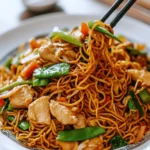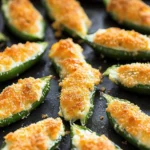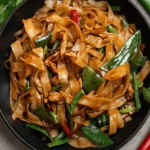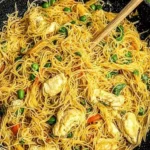These tender beef bao buns bring the magic of dim sum straight to your kitchen. A soft, fluffy dough envelopes a rich filling of ginger-soy braised beef, bursting with umami and fragrant aromatics. Each bite is a blend of pillowy texture and slow-cooked flavor that feels both comforting and gourmet.
Perfect for gatherings, family dinners, or your next culinary challenge, these steamed buns are surprisingly simple to master. The process—from kneading to pleating to steaming—is not just about the food, but the rhythm of creating something from scratch. And when you lift that steamer lid and see your cloud-like creations puffed to perfection, you’ll know it’s worth every minute.
Full Recipe:
For the Dough:
-
3 cups all-purpose flour (sub 1 cup with cake flour for fluffier texture)
-
1 tablespoon sugar
-
1 teaspoon instant yeast
-
3/4 cup warm milk
-
1 tablespoon vegetable oil
-
1/2 teaspoon baking powder
For the Beef Filling:
-
1 lb beef chuck or short rib, finely chopped
-
1 tablespoon sesame oil
-
2 cloves garlic, minced
-
1 teaspoon fresh ginger, grated
-
1/4 cup soy sauce
-
2 tablespoons hoisin sauce
-
1 tablespoon rice vinegar
-
1 teaspoon cornstarch mixed with 1 tablespoon water
-
2 green onions, finely sliced
Directions:
-
In a mixing bowl, combine flour, sugar, and yeast. Stir in warm milk gradually to form a shaggy dough. Knead 8-10 minutes until smooth, then add oil and knead until absorbed. Let rise, covered, for 1 hour until doubled.
-
For the filling, heat sesame oil in a skillet. Add garlic and ginger, sauté 30 seconds. Stir in beef, soy sauce, hoisin, and vinegar. Simmer 10–15 minutes until beef is tender.
-
Add cornstarch slurry, cook until thickened, then stir in green onions. Cool completely.
-
Once dough has risen, knead in baking powder, then divide into 14–16 equal pieces. Roll each into a ball, flatten into a 4-5 inch disc, keeping the center thicker.
-
Place a spoonful of beef filling in each disc. Fold and pleat edges to seal.
-
Place buns on parchment squares in a steamer, let rest 10 minutes. Steam for 12–15 minutes. Turn off heat and let sit covered for 2 minutes before serving.
Prep Time: 25 minutes | Cooking Time: 15 minutes | Total Time: 1 hour 15 minutes
Kcal: 220 kcal | Servings: 16 buns
The Allure of Tender Beef Bao Buns
There’s something universally comforting about biting into a warm, fluffy bao bun. It’s a culinary experience that bridges texture and flavor like few other foods can. The Tender Beef Bao Buns bring this comfort to life through a perfect balance of soft, slightly sweet steamed dough and a deeply savory filling of ginger-soy braised beef. This dish, rooted in Chinese cuisine, is more than just a recipe—it’s a sensory memory in the making.
Bao buns, often referred to as “baozi,” have been enjoyed across East Asia for centuries. While pork fillings are most traditional, beef versions like this one have gained popularity in modern fusion cuisine, offering heartiness with bold, rich flavors that feel familiar yet exotic at once. What sets this recipe apart is its dedication to balance: the contrast between the tender dough and umami-packed beef creates a harmony that satisfies in every bite.
The Cultural Origins of Bao Buns
Bao buns originated in Northern China, historically prepared as a form of portable nourishment that laborers and travelers could carry with them. Traditionally steamed and filled with pork, they quickly evolved across regions and generations. The bun’s purpose remained the same: to serve as a warm, filling vessel for spiced meats or vegetables, encapsulated in a soft, pillowy dough.
As Chinese cuisine traveled globally, bao became a staple not only in homes but also in street food stalls and high-end dim sum parlors alike. In recent years, Western chefs have embraced bao buns, offering their own takes on fillings and presentation. This globalization has transformed bao buns from a traditional snack into an internationally beloved delicacy.
Why This Recipe Works So Well
The appeal of this beef bao recipe lies in both its flavor profile and its versatility. The beef is finely chopped or shredded and cooked slowly in a mixture of soy sauce, hoisin sauce, ginger, garlic, and rice vinegar—ingredients that deliver complexity and depth. A touch of sesame oil ties it all together with a toasty aroma that lingers long after the last bite.
What also makes this recipe accessible is the structure of the dough itself. It’s crafted using basic pantry ingredients—flour, yeast, sugar, warm milk, and a bit of oil—but the result is anything but basic. The dough is light yet chewy, slightly sweet but neutral enough to let the filling shine. A final touch of baking powder ensures the buns puff up beautifully when steamed, giving them their signature soft and glossy finish.
Techniques That Elevate the Bao Bun
Steaming, though it may intimidate beginners, is key to achieving the iconic texture of bao. It’s a gentle cooking method that keeps moisture locked in while allowing the dough to expand and become light. Steaming also helps preserve the integrity of the beef filling, keeping it juicy and succulent rather than dry or overcooked.
Another critical step is pleating. Folding and pinching the dough around the filling might seem purely decorative, but it serves a practical purpose—it seals in flavor and moisture while creating even cooking throughout the bun. Though the pleats take a bit of practice, they quickly become a rhythmic and satisfying part of the bao-making process.
For those without a bamboo steamer, this recipe is flexible. A metal steamer insert or even a DIY setup using a pot and a heatproof plate can yield excellent results. The only non-negotiable? Make sure the buns have space around them in the steamer to expand—otherwise, you’ll end up with sticky, flattened puffs.
Flavor Enhancements and Variations
This recipe shines on its own, but it also invites creativity. Spice lovers can incorporate chopped chilies or a dash of chili oil into the beef mixture for added heat. Vegetarians can substitute beef with crumbled tofu or mushrooms, still using the same flavor base for an equally satisfying result. You can even sneak in steamed bok choy or other vegetables into each bun for a pop of freshness.
For extra brightness, serve these buns with thinly sliced cucumber or pickled daikon radish on the side. A drizzle of black vinegar with ginger slivers or a spoonful of chili crisp takes each bite up a notch.
When and How to Serve Bao Buns
Tender Beef Bao Buns are incredibly versatile. They work as appetizers, entrées, or snacks. Because they are individually portioned, they make fantastic party food or contributions to a potluck. Pair them with a simple soup or salad, and you’ve got a complete meal that’s as comforting as it is elegant.
In family settings, bao buns become interactive food—let kids help shape or fill the dough, or host a bao assembly night where everyone customizes their own fillings. The buns can be made ahead and refrigerated or frozen, making them ideal for meal prep and quick weeknight dinners.
Common Challenges and Tips for Success
A few issues can trip up first-time bao makers, but they’re easily avoided with a little guidance:
-
Dough Not Rising: This usually comes down to expired yeast or cold environments. Make sure your yeast is fresh, and allow the dough to rise in a warm, draft-free space.
-
Dense Buns: This can happen if the dough isn’t kneaded enough or rested properly. Take your time during the kneading process, and don’t rush the rise.
-
Sticking to the Steamer: Always use parchment paper squares or cabbage leaves beneath each bun to prevent sticking.
-
Dry or Tough Filling: Simmer the beef low and slow to allow the connective tissue to break down, resulting in tender, juicy filling every time.
Storing and Reheating
One of the biggest advantages of bao buns is how well they store. Leftover buns can be refrigerated for up to three days or frozen for up to three months. To reheat, simply steam them for 5–8 minutes until warmed through. This gentle reheating method revives both the texture and flavor without drying out the bun or overcooking the filling.
Avoid microwaving, which can lead to rubbery dough and unevenly heated centers. If you’re in a hurry, however, wrap a refrigerated bun in a damp paper towel and microwave in 20-second intervals to get a passable (though not ideal) result.
A Dish That Creates Connection
Beyond the culinary merits, cooking bao buns at home offers something deeper: a connection to tradition, technique, and the joy of shared meals. Whether you’re learning to pleat for the first time or reminiscing about flavors from your childhood, there’s something undeniably meaningful about creating food that brings people together.
These buns may seem simple—just dough and filling—but the care that goes into each fold, each steam, and each bite speaks volumes. Bao buns are about more than nourishment; they’re about pride in craft and the pleasure of home-cooked comfort.
Conclusion
Tender Beef Bao Buns are a celebration of flavor, texture, and tradition. From the savory, slow-cooked beef filling to the impossibly soft steamed dough, each element is thoughtfully crafted to delight the senses. With a balance of sweetness, umami, and warmth, these buns embody the very best of home-cooked Asian cuisine.
Whether you’re preparing them for the first time or returning to a trusted favorite, making bao is an experience that brings satisfaction far beyond the plate. It’s a journey of mindfulness, creativity, and comfort that you can share with those around you. And once you taste the result—a puff of dough yielding to rich, aromatic filling—you’ll understand why bao buns are loved around the world.





